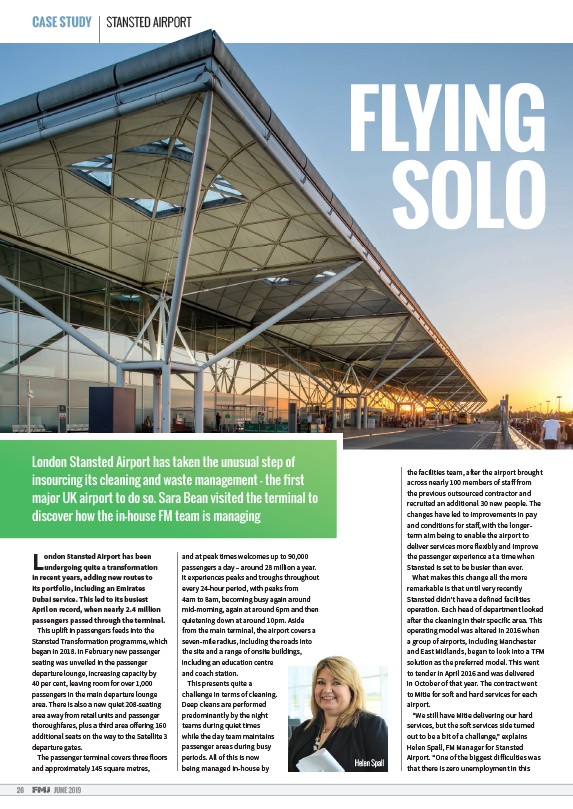
CASE STUDY STANSTED AIRPORT
London Stansted Airport has been
undergoing quite a transformation
in recent years, adding new routes to
its portfolio, including an Emirates
Dubai service. This led to its busiest
April on record, when nearly 2.4 million
passengers passed through the terminal.
This upli in passengers feeds into the
Stansted Transformation programme, which
began in 2018. In February new passenger
seating was unveiled in the passenger
departure lounge, increasing capacity by
40 per cent, leaving room for over 1,000
passengers in the main departure lounge
area. There is also a new quiet 208-seating
area away from retail units and passenger
thoroughfares, plus a third area o ering 160
additional seats on the way to the Satellite 3
departure gates.
The passenger terminal covers three floors
and approximately 145 square metres,
26 JUNE 2019
and at peak times welcomes up to 90,000
passengers a day – around 28 million a year.
It experiences peaks and troughs throughout
every 24-hour period, with peaks from
4am to 8am, becoming busy again around
mid-morning, again at around 6pm and then
quietening down at around 10pm. Aside
from the main terminal, the airport covers a
seven-mile radius, including the roads into
the site and a range of onsite buildings,
including an education centre
and coach station.
This presents quite a
challenge in terms of cleaning.
Deep cleans are performed
predominantly by the night
teams during quiet times
while the day team maintains
passenger areas during busy
periods. All of this is now
being managed in-house by
FLYING
SOLO
Helen Spall
the facilities team, a er the airport brought
across nearly 100 members of sta from
the previous outsourced contractor and
recruited an additional 30 new people. The
changes have led to improvements in pay
and conditions for sta , with the longerterm
aim being to enable the airport to
deliver services more flexibly and improve
the passenger experience at a time when
Stansted is set to be busier than ever.
What makes this change all the more
remarkable is that until very recently
Stansted didn’t have a defined facilities
operation. Each head of department looked
a er the cleaning in their specific area. This
operating model was altered in 2016 when
a group of airports, including Manchester
and East Midlands, began to look into a TFM
solution as the preferred model. This went
to tender in April 2016 and was delivered
in October of that year. The contract went
to Mitie for so and hard services for each
airport.
“We still have Mitie delivering our hard
services, but the so services side turned
out to be a bit of a challenge,” explains
Helen Spall, FM Manager for Stansted
Airport. “One of the biggest di iculties was
that there is zero unemployment in this
London Stansted Airport has taken the unusual step of
insoXrcinJ its cleaninJ and Zaste PanaJePent Ƈ the fi rst
major UK airport to do so. Sara Bean visited the terminal to
discover how the in-house FM team is managing